Ruth Ellen Gruber's Blog, page 25
February 7, 2011
Middle East -- Synagogue being restored in Damascus
This is off geographical topic, but Bloomberg runs a piece by Massoud A. Derhally noting a project begun in December to restore synagogues in Damascus, Syria.

Albert Cameo, leader of what remains of the Jewish community in Syria, says he's trying to fulfill an obligation to his religious heritage. The 70-year-old is organizing the restoration of a synagogue called Al-Raqi in the old Jewish quarter of Damascus built during the Ottoman Empire about 400 years ago. The project, which began in December, will be completed this month as part of a plan to restore 10 synagogues with the backing of Syrian President Bashar al-Assad and funding from Syrian Jews.
"Assad sees the rebuilding of Jewish Damascus in the context of preserving the secularism of Syria," said Josh Landis, director of the Center for Middle East Studies at the University of Oklahoma in Norman. "This is an effort by the regime to show its seriousness and an olive branch to the Jewish community in America, which they have been wooing."
While Syria is still officially at war with Israel, the country is trying to portray itself as a more tolerant state to help burnish its image internationally. Syria's 200 Jews are mirroring the actions of their co-religionists in Lebanon, where restoration work began on Beirut's Maghen Abraham Synagogue in July 2009.
Published on February 07, 2011 10:55
February 6, 2011
Candlesticks on Stone -- cross post from the blog
Here's a crosspost from the Candlesticks on Stone blog, considering the question of when did candlesticks become standard shorthand for denoting a woman.
By Ruth Ellen Gruber
Using candlesticks and candelabra to denote women on tombstones was very common by the mid to late 19th century in the parts of Eastern Europe where I have been focusing this study (northern Romania/Ukraine/Poland and surrounding territory). Indeed, by the late 19th century and early 20th century this imagery was utilized almost across the board (though birds and flowers were also used), and there was even a variety of pre-fab templates of fanciful candlesticks, including the style that marked the grave of of my great-great-grandmother, Chaya Dwoira, in the Jewish cemetery in Radauti.
These templates are striking but not great examples of stone-carving — though they derived from the wonderfully sculpted and imaginative stones of the 18th and early 19th centuries (and even in the 17th century). But, when massed together in a crowd, as in Radauti, they are very impressive nonetheless, providing a sense of — well — community or communality, in a way. 100 years and more ago they would have presented even a more striking sight, as they would have been painted bright colors.
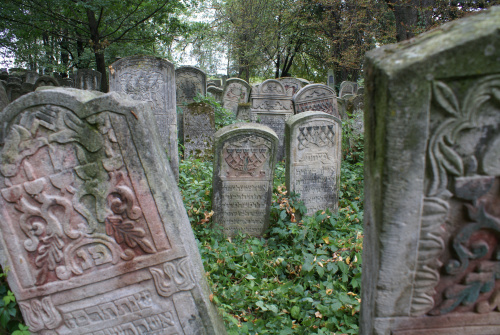 Amid the forest of stones, the tomb of Chaya Dvoira (small stone in middle, at left)
Amid the forest of stones, the tomb of Chaya Dvoira (small stone in middle, at left)
Some of these "off the shelf" designs are rooted in the earlier designs of braided candelabra branches and bases that formed the mystical "endless knot" motif. Others attach leaves or sprouts to the candelabras, referring, I imagine to the also mystical "candelabra/menorah as tree of life" motif. Some show hands blessing the flames; others do not. What is interesting, too, is that even stones that looks as if they were carved from identical stencils often differ in subtle ways — note, for example, how the hands are carved differently, and how there are other slight differences in the ornamentation.
 Radauti -- tremplate design with candles sprouting leaves
Radauti -- tremplate design with candles sprouting leaves
 Radauti -- tremplate designs with candles sprouting leaves
Radauti -- tremplate designs with candles sprouting leaves
When did the candlesticks imagery become the norm?
In the Old Jewish Cemetery in Siret, Romania, some of the women's tombs dating to the very early 19th century bear candle imagery (one has the representation of an antique-looking menorah, others with more fanciful candelabra, in combination with plant motifs).
And some candelabra or candle-bearing stones in Ukraine date back as early as the mid-18th century. These were documented by the researcher Boris Khaimovich from the Center for Jewish Art, who did his PhD on 17th and 18th century Jewish tombstones in Ukraine. Boris reports that the stone of Esther daughter of Yitzchak, which dates from 1781, is one of the oldest stones in the Jewish cemetery in Kosuv, Ukraine. It shows hands blessing the flames on a seven-branched Menorah and may be one of the earliest stones to bear this image of blessing hands.
Otherwise, the older stones do not seem necessarily to use a specific visual signifier for woman. In the cemetery at Sataniv, for example, the tombstone of Rivkah bat Eliezar Susman, from 1803, bears the mysterious "three hares" carving — three hares joined at the ears an in optical illustion — in a floral medallion flanked by birds and griffons.
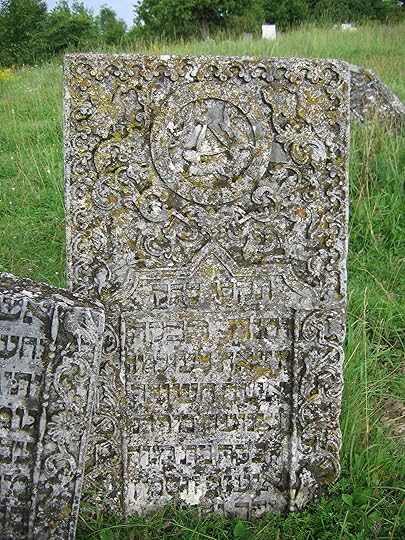 Sataniv, Ukraine, 2006 -- woman's tomb with the Three Hares motif
Sataniv, Ukraine, 2006 -- woman's tomb with the Three Hares motif
By Ruth Ellen Gruber
Using candlesticks and candelabra to denote women on tombstones was very common by the mid to late 19th century in the parts of Eastern Europe where I have been focusing this study (northern Romania/Ukraine/Poland and surrounding territory). Indeed, by the late 19th century and early 20th century this imagery was utilized almost across the board (though birds and flowers were also used), and there was even a variety of pre-fab templates of fanciful candlesticks, including the style that marked the grave of of my great-great-grandmother, Chaya Dwoira, in the Jewish cemetery in Radauti.
These templates are striking but not great examples of stone-carving — though they derived from the wonderfully sculpted and imaginative stones of the 18th and early 19th centuries (and even in the 17th century). But, when massed together in a crowd, as in Radauti, they are very impressive nonetheless, providing a sense of — well — community or communality, in a way. 100 years and more ago they would have presented even a more striking sight, as they would have been painted bright colors.
 Amid the forest of stones, the tomb of Chaya Dvoira (small stone in middle, at left)
Amid the forest of stones, the tomb of Chaya Dvoira (small stone in middle, at left)Some of these "off the shelf" designs are rooted in the earlier designs of braided candelabra branches and bases that formed the mystical "endless knot" motif. Others attach leaves or sprouts to the candelabras, referring, I imagine to the also mystical "candelabra/menorah as tree of life" motif. Some show hands blessing the flames; others do not. What is interesting, too, is that even stones that looks as if they were carved from identical stencils often differ in subtle ways — note, for example, how the hands are carved differently, and how there are other slight differences in the ornamentation.
 Radauti -- tremplate design with candles sprouting leaves
Radauti -- tremplate design with candles sprouting leaves Radauti -- tremplate designs with candles sprouting leaves
Radauti -- tremplate designs with candles sprouting leavesWhen did the candlesticks imagery become the norm?
In the Old Jewish Cemetery in Siret, Romania, some of the women's tombs dating to the very early 19th century bear candle imagery (one has the representation of an antique-looking menorah, others with more fanciful candelabra, in combination with plant motifs).
And some candelabra or candle-bearing stones in Ukraine date back as early as the mid-18th century. These were documented by the researcher Boris Khaimovich from the Center for Jewish Art, who did his PhD on 17th and 18th century Jewish tombstones in Ukraine. Boris reports that the stone of Esther daughter of Yitzchak, which dates from 1781, is one of the oldest stones in the Jewish cemetery in Kosuv, Ukraine. It shows hands blessing the flames on a seven-branched Menorah and may be one of the earliest stones to bear this image of blessing hands.
Otherwise, the older stones do not seem necessarily to use a specific visual signifier for woman. In the cemetery at Sataniv, for example, the tombstone of Rivkah bat Eliezar Susman, from 1803, bears the mysterious "three hares" carving — three hares joined at the ears an in optical illustion — in a floral medallion flanked by birds and griffons.
 Sataniv, Ukraine, 2006 -- woman's tomb with the Three Hares motif
Sataniv, Ukraine, 2006 -- woman's tomb with the Three Hares motif
Published on February 06, 2011 20:32
February 4, 2011
Romania -- Lo-Tishkach publishes a gallery of my photos
By Ruth Ellen Gruber
The Lo-Tishkach web site has published a gallery of my photos of Jewish cemeteries in Romania. You can view it by clicking HERE
The Lo-Tishkach web site has published a gallery of my photos of Jewish cemeteries in Romania. You can view it by clicking HERE
Published on February 04, 2011 11:28
February 2, 2011
Candlesticks on Stone -- Tombstone Typology
By Ruth Ellen Gruber
I have created a rather cool page on my (Candle)sticks on Stone web site, showing some of the many different types and styles of candlesticks used to decorate the tombstones of women in Eastern Europe.

I have created a rather cool page on my (Candle)sticks on Stone web site, showing some of the many different types and styles of candlesticks used to decorate the tombstones of women in Eastern Europe.
They range from what I would call "classic" Shabbos candles — two matched candles in individual candle-holders — to multi-branched candelabra (including seven-branched menorahs) of various types. Some of them look as if they could have come off of a household's shelf. Others look like classic Menorahs of antiquity. Many are elaborately ornamental but still look like physical objects. But others still are intricate figures that weave and twist and entwine the branches of the menorah and/or the base of the menorah into fanciful convoluted forms. And some clearly combine the imagery of the Menorah with that of the Tree of Life — or, perhaps, of death, as in some examples the branches of the menorah may look like snakes.
Some stones bear images of hands blessing the flames.
In their fascinating and wonderful book Traditional Jewish Papercuts: An Inner World of Art and Symbol (Hanover NH, 2002), Joseph and Yehudit Shadur write that the intricately convoluted menorah forms appear almost exclusively in two places — in traditional East European Jewish paper cuts (where they are often dominant compositional elements) and on some East European Jewish tombstones. They appear to represent a development of the "endless knot" motif.
The Shadurs write (pp 170-171):As far as we could ascertain, neither the convoluted menorah configurations nor the endless-knot motif have ever been considered as distinct visual symbols in Jewish iconography. And yet, they are so common and figure so prominently in East-European Jewish papercuts that they can hardly be regarded as mere decorative motifs.They theorize thatthe metamorphosis of the traditional menorah of antiquity and the Middle Ages into the convoluted, endless-knot configurations appearing in the papercuts coincides with the spread and growing popularization of messianic mysticism and the Kabbalah throughout the Jewish communities of Eastern Europe from the early eighteenth century on [.]In her book A Tribe of Stones, Jewish Cemeteries in Poland (Warsaw 1994) Monika Krajewska, a post-World War II pioneer in the study of gravestone imagery — who is also an accomplished paper-cut artist, likens the twisted menorahs to the braiding of Challah loaves — and in a way, that would mean that the images denote two of the three "women's commandments" (lighting the Shabbos candles, "taking Challah" or removing a piece of dough when baking bread, and Niddah, or keeping menstrual purity).
Published on February 02, 2011 15:57
January 26, 2011
Krakow -- looking toward Festival of Jewish Culture
People often ask what it's like at the Festival of Jewish Culture in Krakow... this Polish television video from 2004 of David Krakauer, Josh Dolgin (So-Called) and group captures the atmosphere at the marathon final concert held the last Saturday night of the festival.
I was there, down front -- as the picture below (which I took) bears witness!
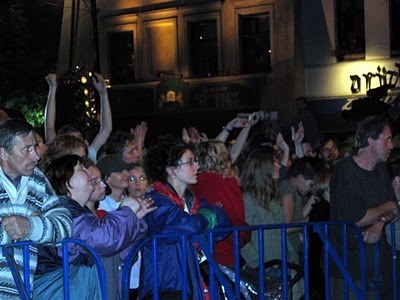 Final concert, Krakow. 2004. Photo (c) Ruth Ellen Gruber
Final concert, Krakow. 2004. Photo (c) Ruth Ellen Gruber
I was there, down front -- as the picture below (which I took) bears witness!
 Final concert, Krakow. 2004. Photo (c) Ruth Ellen Gruber
Final concert, Krakow. 2004. Photo (c) Ruth Ellen Gruber
Published on January 26, 2011 20:56
January 24, 2011
Exhibitions -- Epstein show in Kiev prolonged
Just a note -- Leonid Finberg advises that the Mark Epstein exhibit at the National Art Museum in Kiev has been prolonged until Feb. 17. I posted on the exhibit a couple of day ago.
Published on January 24, 2011 06:19
January 22, 2011
Candlesticks on Stone -- Videos added to web site
By Ruth Ellen Gruber
I have added some videos to my Candlesticks on Stone web site -- click HERE for the link.
I have added some videos to my Candlesticks on Stone web site -- click HERE for the link.
Published on January 22, 2011 08:17
January 21, 2011
Candlesticks on Stone -- HBI announcement of my fellowship
By Ruth Ellen Gruber
Here's the link to the page on the web site of the Hadassah Brandeis Institute announcing my fellowship as scholar in residence -- click HERE

Here's the link to the page on the web site of the Hadassah Brandeis Institute announcing my fellowship as scholar in residence -- click HERE
While at the HBI, Ruth will be working on (Candle)sticks on Stone: Representing the Woman in Jewish Tombstone Art (begun in 2009 with an HBI research grant), which centers on a photographic documentation of the often elaborate tombstones of women in the historic Jewish cemeteries in Eastern Europe, mainly in and around the Bucovina region of northern Romania -- including the Jewish cemetery in Radauti, where some of her ancestors are buried. Focusing on the remarkably varied sculptural representation of candlesticks on these tombs, the project fuses visual documentation and photographic art with research, reportage, reflection and memoir. It encompasses issues of gender, identity and tradition and explores how tradition is (or is not) transmitted. The project is centered on a public web site and blog, but will also result in more traditionally published works.
The Candlesticks web site is http://candlesticksonstone.wordpress.com
Published on January 21, 2011 21:17
Ukraine -- Mark Epstein Exhibition in Kiev
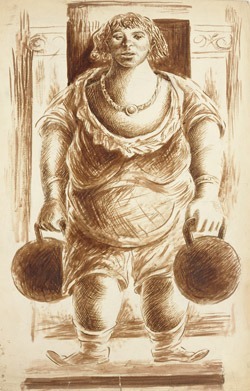 From National Art Museum web site.
From National Art Museum web site.By Ruth Ellen Gruber
I gladly pass on information received from Leonid Finberg in Kiev about a current exhibition at the National Art Museum there of the work of the avant garde Kiev painter Mark Epstein, who was active in the 1920s. (THIS LINK to the museum web site provides information in Ukrainian.)
The exhibition presents works of the Kiev period of Epstein's life and represents Epstein's first solo show. It opened in mid-December and runs til the end of January.
The Kiev Judaic institute has published a book on Epstein to go with the exhibit, Mark Epstein. Return of the Master , that includes illustrations of approximately 60 of Eptein's works, most of which are published here for the first time.
Dr. Finberg adds:
Mark Epstein was a notable figure in the artistic life of Kyiv during the 1920's. In 1928, having just finished the Kyiv Arts College , he immersed himself into the progressive arts movement of that time. He attended O. Exter's art studio where his newest creative ideas were polished. Mark Epstein's cubic-futurist works of the beginning of the 1920's – Violoncellist, Family, Tailor, The Two, A Woman with a Yoke – have become part of the history of modern Ukrainian art.
Epstein was one of the founders of the artistic section of the Culture League – an association whose aim was the development of Jewish culture. Members of the section also included O.Tishler, El Lysytsky, J. Chaikov, S. Nikritin, and others. Marc Chagall, N. Altman, R. Falk, and D. Sterenberg also cooperated with the Culture League. In their effort to create new Jewish art, members of the Culture League synthesized images of traditional art with Ukrainian avant-garde ideas.
Epstein took an active part in this work. Unfortunately, only the graphic works of Epstein have been preserved from the 1920's; representations of his sculptures have survived only as photos, while his paintings have been totally lost.
The work of the Culture League was terminated in the middle of the 1920's. In 1932, Epstein had to move to Moscow . He took practically no part in exhibitions there, but worked a great deal. However his attempts to adjust his talent to the requirements of the times bore no evident fruit.
Published on January 21, 2011 13:02
January 18, 2011
Poland --evocative blog posts about Lesko cemetery (and synagogue)
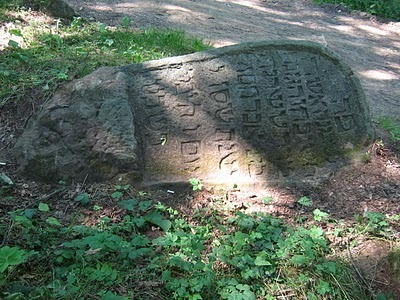 Lesko Jewish cemetery, 2006. Photo (c) Ruth Ellen Gruber
Lesko Jewish cemetery, 2006. Photo (c) Ruth Ellen GruberBy Ruth Ellen Gruber
I have just come across two very detailed blog posts about the synagogue and ancient Jewish cemetery in Lesko, in the far southeastern corner of Poland.
Both posts, on http://riowang.blogspot.com, are very informative and richly illustrated with photographs -- they make me wish I had spent more time in Lesko when I was last there, in 2006, updating JHT.
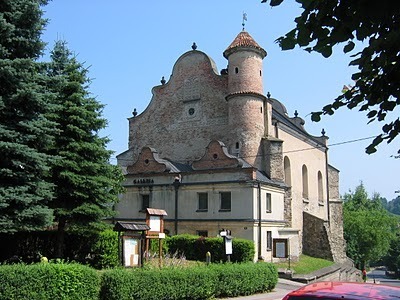 Lesko synagogue, 2006. Photo (c) Ruth Ellen Gruber
Lesko synagogue, 2006. Photo (c) Ruth Ellen Gruber
Published on January 18, 2011 19:36



